Serving since 1967, SMART is Southeast Michigan’s only regional public transportation provider, offering convenient, reliable and safe transportation for Macomb, Oakland and Wayne Counties. SMART’s Fixed-Route and small bus services connect people to employment and educational institutions. SMART is supported by federal and state funding, local contributions through a transit property tax millage from opt-in communities and bus fares.
- SMART bus routes provide access to more than 67,000 businesses and 850,000 jobs
- Approximately 2 million people live within a ¼ mile radius of a SMART bus route
- Over 9 million people including seniors, students and professionals use SMART to travel to work, school, doctor’s offices and shopping centers annually
- All SMART buses are equipped with bike racks
- The SMART bus system offers a variety of Fixed-Route and curb-to-curb service options and programs with 47 bus routes and over 5,300 bus stops
- New SMART drivers receive nearly 280 hours of training including 200 hours of on-the-road training
- On average, SMART bus drivers drive 21,000 miles accident free
- SMART buses receive preventative maintenance every 3,000 miles
- All SMART buses are equipped with VoIP (Voiceover I.P.), turn-by-turn GPS and auto vehicle locator systems
- SMART Fixed Route bus riders utilize the service for daily activities, with 71% using SMART to get to work, 7% using it for shopping trips and medical needs, and 2% using it to reach educational institutions
- SMART buses are on time 86% of the time
- Nearly 56% of new Fixed-Route riders prefer using SMART over their own vehicle or other means of transportation
- One SMART bus potentially eliminates 60 cars on the road
- SMART continues to add hybrid electric buses to its fleet, reducing carbon emissions
- Public transportation produces 95% less volatile carbon monoxide and about 50% as much carbon dioxide and nitrogen oxide per passenger per mile
- SMART recycles 600 tires, 4,224 gallons of anti-freeze and 12,554 gallons of oil (motor and transmission) annually
- All SMART buses are biodiesel powered
- A 31 Day Pass costs less than two fill-ups at the pump
- Through its Specialized Services, Municipal and Community Credits programs, SMART redistributes approximately $7.8 million annually to 137 community-based transit programs
- SMART offers transit programs and tax incentives for businesses and their employees
- SMART is governed by a board of directors comprised of representatives from Macomb, Monroe, Oakland and Wayne Counties, which selects the general manager to handle daily operations
- Tiffany J. Gunter - General Manager
- Harmony Lloyd - Deputy General Manager
SMART provides employment for nearly 900 people in Southeast Michigan. The employees are represented by the following unions:
ATU Local 1564
- Fixed Route Bus Operators
- Customer Information Operators
- Certain Office & Clerical personnel
|
AFSCME Local 1786
- Dispatchers
- Road Supervisors
- Maintenance Supervisors
- Community Transit Dispatch Inspectors
- Vault Pullers
|
TEAMSTERS Local 247
- Community Transit Vehicle Operators
- Customer Service Operators & Clerks
|
UAW Local 771
|
| Average weekday (Fixed Route and Connector) |
29,000 |
| Average length of ride on Connector |
7.5 Miles |
| Average length of ride on Fixed Route service |
8.2 Miles |
| Vehicle Type |
Vehicles |
Fixed Route
SMART Connector Paratransit
Community Transit Providers*
Purchase of Service*
Total |
255
120
298
53
726 |
*Vehicles owned by SMART but operated by a local community
The following history of transit in the southeast Michigan region is a chronology of impressive growth in transit services as well as disappointing decline and diminishing of transit service in the area. As you will see, the region once was a leader in public mass transit. In the last 50 years, the region not only fell far behind the rest of the nation in mass transit development but it sacrificed much of what it once was.
It is not the intent of this chronology to dwell on the failures of the past. However, it is important to understand the history of regional mass transit to be better prepared to change that history and develop a new and vital regional rapid mass transit system.
1800s
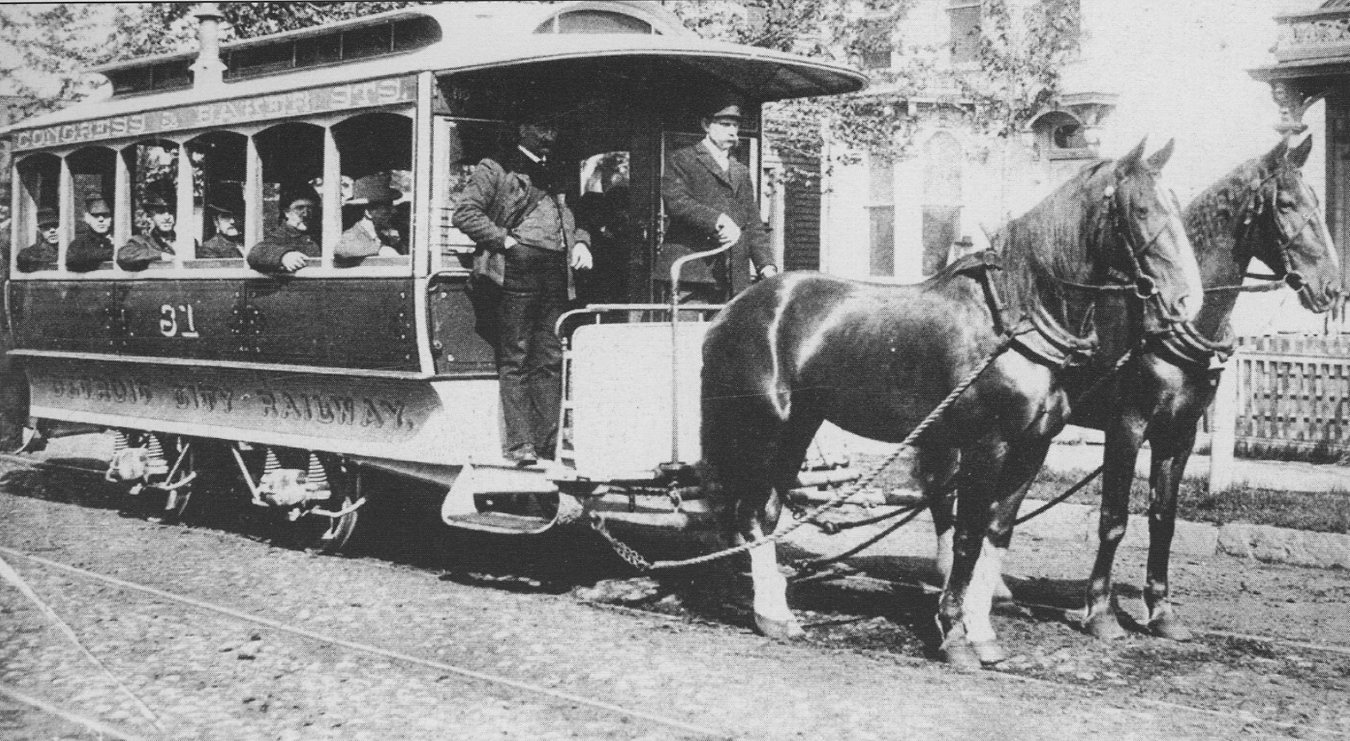
- 1860 – The population of Detroit is about 50,000 and the land area of the city is 12.7 square miles.
- 1862 – A Syracuse, New York based company forms the Detroit City Railway Company and begins construction of what would be Detroit’s first passenger rail system.
- 1863 – Detroit’s first passenger rail system, horse-drawn trolleys, begins service on Jefferson Avenue on August 3, 1863. The initial service ran from Elmwood to Randolph. The fare was 5 cents or 25 tickets for a dollar. On August 27, 1863 service began on Woodward Avenue, on September 12, 1863 service began on Gratiot Avenue and on November 25, 1863 service began on Michigan Avenue. All of the lines converged at Jefferson and Woodward Avenues.
- 1892 – On August 22, 1892 the Detroit Citizens Street Railway succeeds the Detroit City Railway and begins to offer electric powered streetcar service along Jefferson Avenue. Electric streetcars replace the horse-drawn trolley on Woodward and Mack by the end of the year.
- 1895 - Due to the improved power electric streetcar service expands into the suburbs.
1900 - 1950
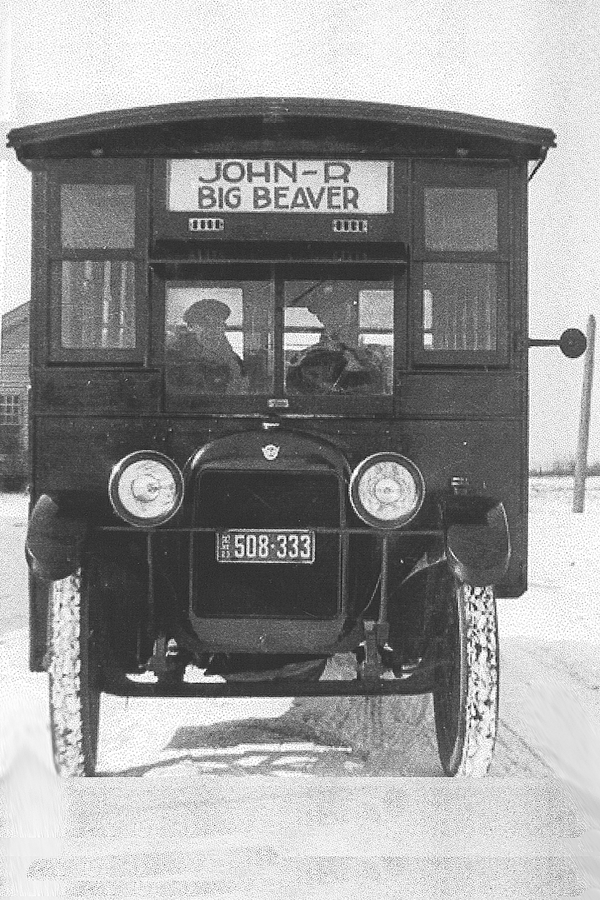
- 1900 – The population of Detroit is 285,704 and the land area of the city is 28.3 square miles. The population of the tri-county region is 426,829
- 1901 – The DUR (Detroit United Railway) is formed by a Cleveland syndicate from six Detroit area interurban operations.
- 1910 – The population of Detroit is 465,766 and the land area of Detroit is 39.3 square miles. The population of the tri-county region is 613,773.
- 1919 – The Detroit Rapid Transit Commission prepares the first Regional Transportation Plan (RTP) recommending a multi-modal system.
- 1920 – The population of Detroit is 993,678 and the population of the tri-county region is 1,305,798.
- 1920 – Mayor James Couzens vetoes a bond issue to build a subway system and the override failed by one vote, keeping the city from developing a subway system.
- 1920 – Detroit voters approve Mayor Couzens’ proposal to build and operate a municipally owned transit operation.
- 1921 – On February 1, 1921 the city began operation of the Municipal Operation, or the “M.O.” with 2 lines totaling 13 miles. By the end of 1921 the M.O. built an additional 52.6 miles of track, but still did not access the downtown area.
- 1922 – Led by Mayor James Couzens, the City of Detroit purchases DUR for $19,850,000 and takes over streetcar operations becoming the largest municipality owned transit system in the country, with 363 miles of track, 4,000 employees and 1,457 streetcars and the Department of Street Railways (DSR) is formed.
- 1925 – The first buses start operating in the city.
- 1930 – The population of Detroit is 1,568,662 and the land area is 139 square miles. The
population of the tri-county region is 2,177,343.
- 1931 – The Grand Trunk Western Railroad begins commuter service between Detroit and Pontiac, making the trip in 45 minutes.
- 1933 – Detroit voters approve a subway plan but the state advisory board refuses to recommend construction to the Federal government.
- 1934 – The DSR was operating 1,600 street cars on 19 routes.
- 1934 – DSR General Manager Fred Nolan begins a campaign to replace all street cars with buses.
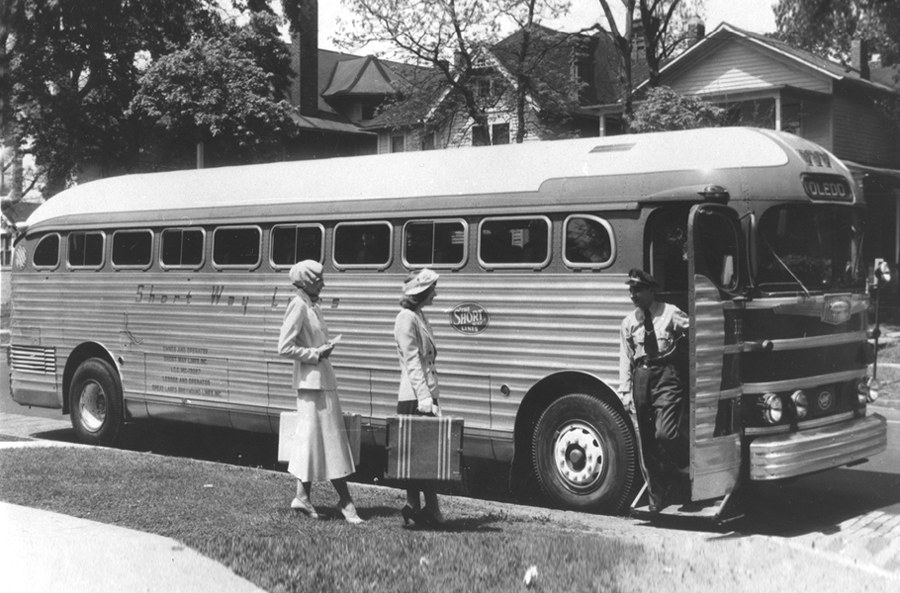
- 1940 – The Population of Detroit is 1,623,452 and the land area remains at 139 square miles. The population of the tri-county region is 2,377,329.
- 1940s – The peak period for the Detroit regional transit system, with an annual ridership of 490 million that had choices of buses, street cars and commuter rail.
- 1945 – The DSR was operating with 908 street cars on 19 different routes.
1950 - 2000
- 1950 – The population of Detroit is 1,849, 568 and the land area remains at 139 square miles. The population of the tri-county region is 3,016,197.
- 1951 – A major transit strike lasting 2 months severely damages ridership.
- 1953 – The Detroit Metropolitan Area Transportation Study calls for a balanced system of highways and mass transit.
- 1956 – In April Detroit streetcar service ends after 93 years.
- 1958 – The Detroit Rapid Transit Commission publishes a plan that calls for a regional monorail system.
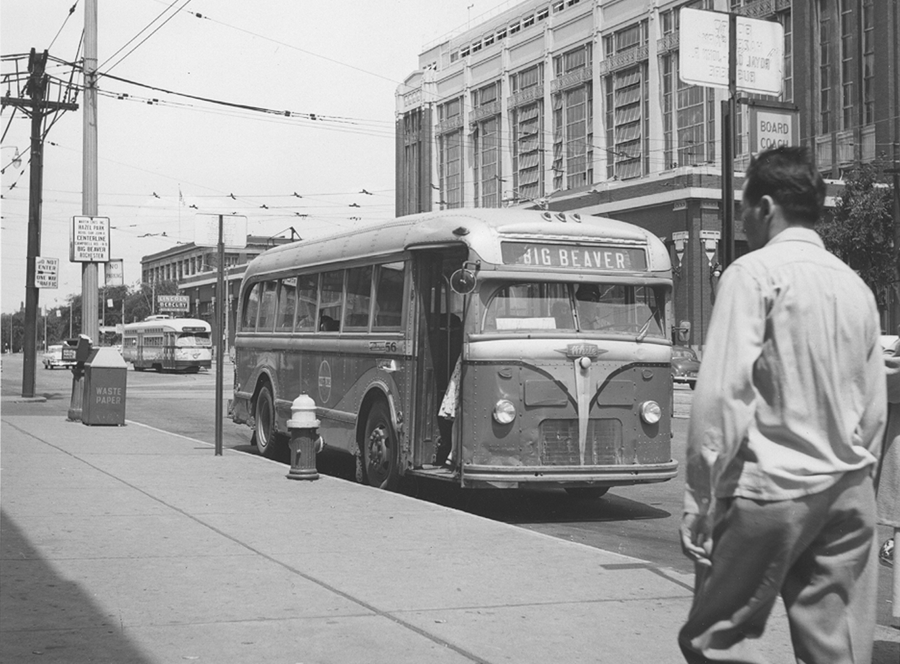 1960 – The population of Detroit drops to 1,670,144 and the land area remains at 139 square miles. The population of the tri-county region grows to 3,762,360.
1960 – The population of Detroit drops to 1,670,144 and the land area remains at 139 square miles. The population of the tri-county region grows to 3,762,360. - 1964 – The DSR General Manager Lucas Miel proposed a merger of the DSR with a proposed tri-county transit agency, “Rapid Transit Authority.” The merger would allow the DSR to receive tax subsidies and expand its service into the suburbs. The effort failed to garner public or political support.
- 1964 – In September the Detroit Common Council approved a charter amendment that allowed the city to appropriate from its general fund needed matching monies needed for the DSR to obtain federal grants, helping the DSR to stay afloat. While it addressed the DSR’s funding problems it did not address the need for regional transit
- 1967 – The Michigan State Legislature passed the Metropolitan Transportation Authorities Act of 1967. (Public Act 204). Under a provision (section 124.405) the Southeastern Michigan Transportation Authority (SEMTA) was formed to take over the financially strapped suburban mass transit service in Wayne, Oakland and Macomb Counties, including the City of Detroit. SEMTA included the counties of Macomb, Monroe, Oakland, St. Clair, Washtenaw and Wayne. SEMTA acquired the DSR as well as the Port Huron Transit Company, the Pontiac Transit Corporation, The BEE Line and others. However, the new legislation did not provide SEMTA with any means to levy taxes or any continuing source of funding.
- 1969 – The Detroit Regional Transportation and Land Use Study (TALUS) recommended rail rapid transit in eight major region corridors.
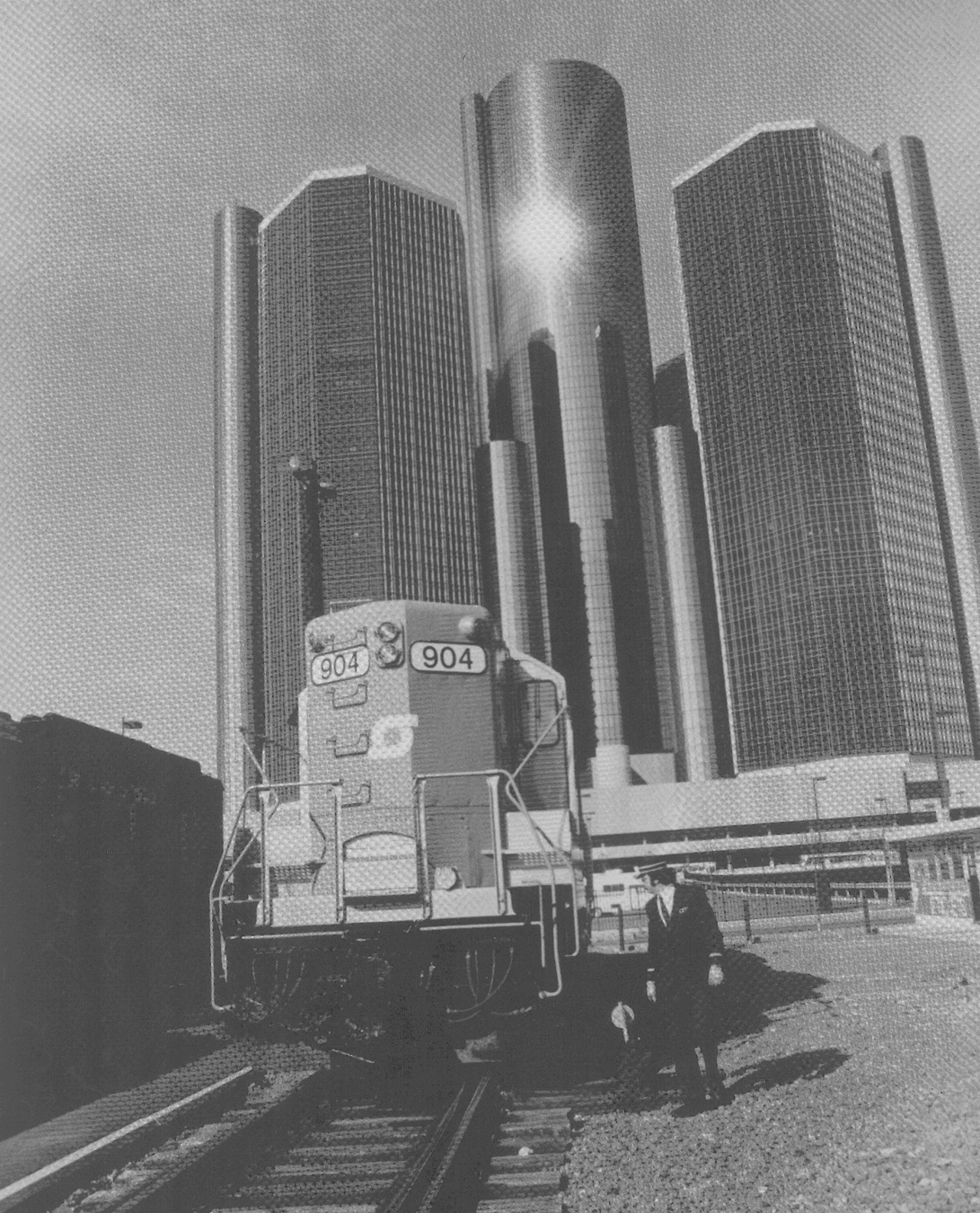 1970 – The population of Detroit drops to 1,514,063 and the land area remains at 139 square miles. The population of the tri-county region is 4,203,548.
1970 – The population of Detroit drops to 1,514,063 and the land area remains at 139 square miles. The population of the tri-county region is 4,203,548. - 1971 – In May the Lake Shore Express, which provided service between the five Grosse Pointe communities and St. Clair Shores into Detroit was acquired by SEMTA. The six communities provided SEMTA the needed 1/3 matching funds needed to obtain enough federal funds to purchase the Lake Shore Coach Lines.
- 1973 – In January Governor Milliken signed amendments to Act 51, Act 327 Public act of 1972 which established a state-wide General Transportation Fund, created within the state’s motor vehicle highway fund, which provided ½ cent per gallon for public transit.
- 1974 – SEMTA takes over financial responsibility for the Detroit – Pontiac commuter service from the Grand Trunk.
- 1974 – The DSR is re-organized as the Detroit Department of Transportation (DDOT).
- 1976 – President Gerald Ford offers the southeast Michigan $600 Million to build a rail transit system. Other than the People Mover nothing was developed due to the lack of local/regional political support.
- 1979 – SEMTA approved a regional transit plan which includes the development of rail lines and an improved bus system. However subsidies were cut and the plans were never implemented. SEMTA soon reduced transit service and laid-off employees.
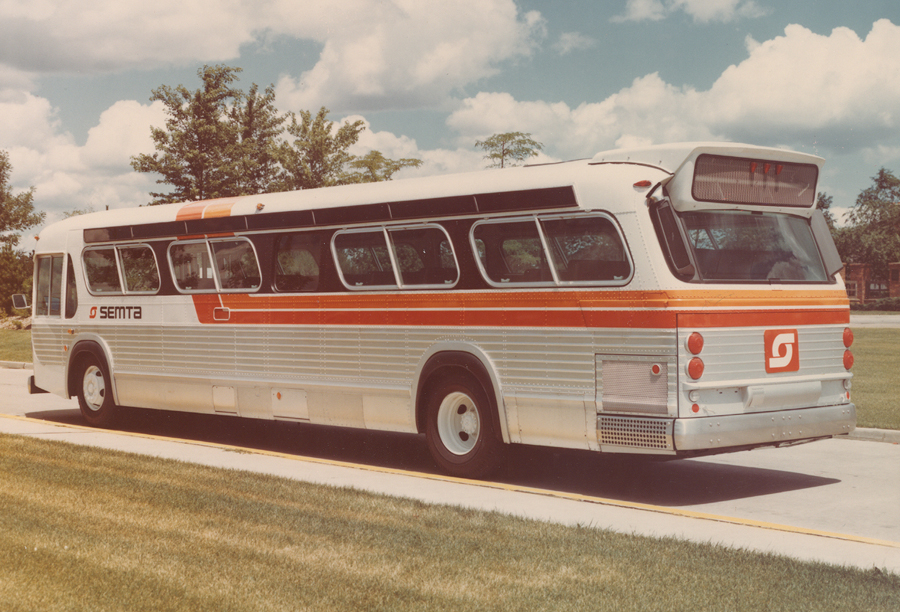 1980 – The population of Detroit drops to 1,203,368. The population of the tri-county region declines to 4,044,236.
1980 – The population of Detroit drops to 1,203,368. The population of the tri-county region declines to 4,044,236. - 1983 – SEMTA terminates the Detroit – Pontiac commuter service.
- 1984 – SEMTA terminates the Detroit – Ann Arbor commuter service.
- 1984 – Regional leaders approve the Regional Public Transportation Consensus Plan, a refined version of the 1979 regional transit plan. The plan was never implemented.
- 1985 – AMTRAK offers matching funds to build a passenger rail station at Joe Louis Arena and to restart commuter service between Detroit and Ann Arbor. Local matching funds could not be developed and the proposed project was dropped.
- 1987 – The “People Mover” downtown transit line was built at a cost of $67 Million per mile.
- 1988 – On December 7, 1988 Public Act 204 was amended and SEMTA was restructured from its seven-county operation into a three-county agency, which excluded the City of Detroit and renamed the Suburban Mobility Authority for Regional Transportation (SMART). SMART began operations on January 17, 1989.
- 1989 – On January 12, 1989 to provide effective and efficient public transportation in southeast Michigan, through planning, and coordination the Mayor of the City of Detroit, Chairman of the Macomb County Board of Commissioners, Oakland County Executive and Wayne County Chief Executive Officer adopted Articles of Incorporation and formed the Regional Transit Coordinating Council (RTCC).
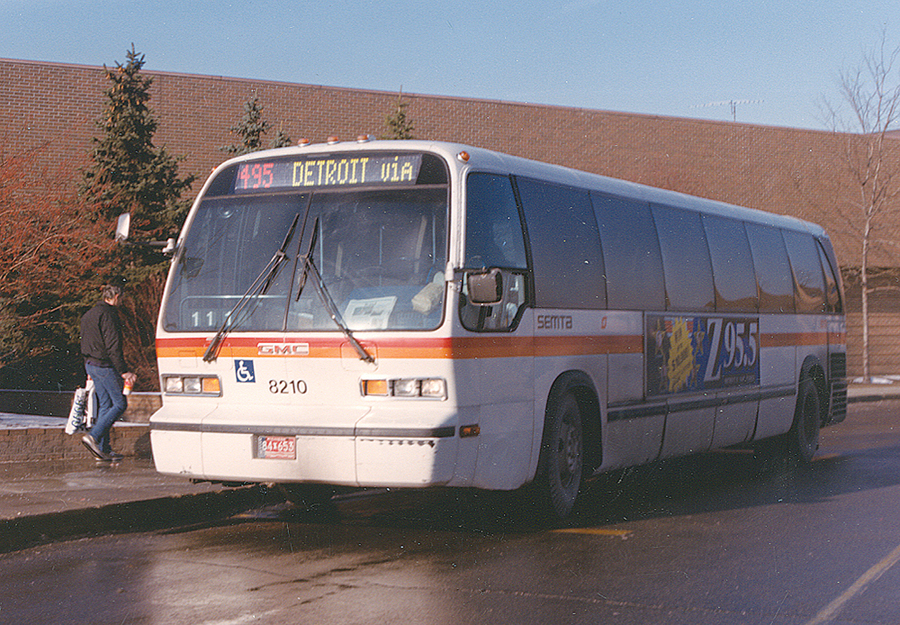 1990 – The population of Detroit drops to 1,027,924. The population of the tri-county region is 3,912,679.
1990 – The population of Detroit drops to 1,027,924. The population of the tri-county region is 3,912,679. - 1994 – SMART and DDOT attempted to merge five routes but the project was cancelled.
- 1995 – A local .33 property tax millage is placed on the ballot and successfully passes in all of Macomb County and portions of Wayne and Oakland to support operations of SMART.
- 1996 – SMART and DDOT establish a common regional bus pass but further attempts to merge services fail.
- 1996 – SMART establishes the Community Partnership Program to support local transit in communities for seniors and people with disabilities.
- 1997 – The Michigan Department of Transportation (MDOT) publishes a report recommending the restart of commuter rail service between Detroit and several regional communities at a capitol cost of $2 million per mile. The recommendation was considered to be too expensive by regional leaders.
- 1998 – DDOT terminates its suburban service. SMART picks up the abandoned routes.
- 1999 – General Motors removes the commuter rail spur that is west of the Renaissance Center to make room for a parking deck.
- 1999 – MDOT announces a plan to extend I-375 toward the river, eliminating downtown rail access.
2000s
- 2000 – The population of Detroit drops to 951,270. The population of the tri-county region is 4,043,467.
- 2001 – SEMCOG adopts a Regional Transit Vision for the 7-county region.
- 2001 – The Detroit Regional Chamber spearheads legislation to create a Detroit Area Regional Transportation Authority (DARTA).
- 2002 – Legislation to form DARTA is vetoed by Governor John Engler.
- 2002 – SMART millage is increased from .33 mils to .59 mils and successfully passes in all three counties.
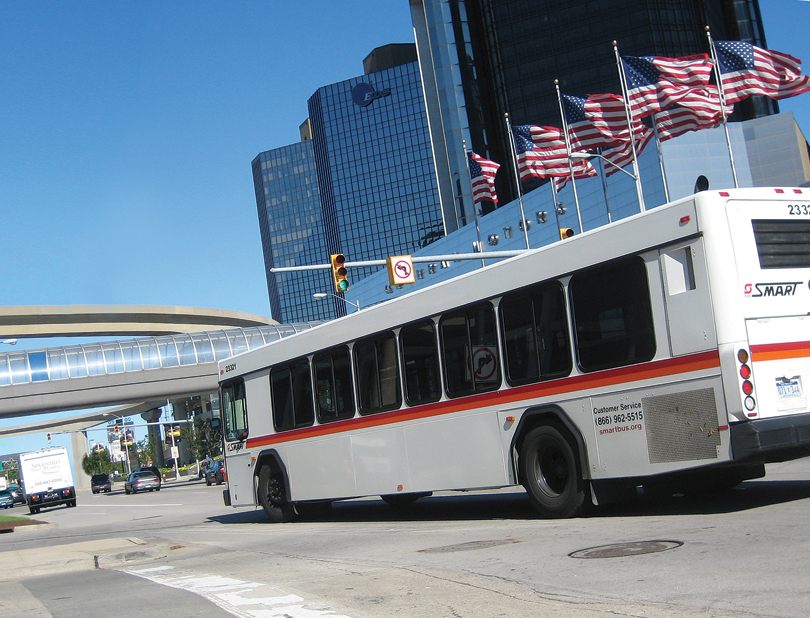 2003 – In May of 2003 DARTA is formed through an interlocal inter-government agreement (IGA) that includes the City of Detroit, Wayne County, Macomb County, Oakland County, Monroe County and SMART. The agreement proposed that the parties utilize existing constitutional and statutory law to establish more effective and efficient public transportation services. Under this agreement the parties agreed to transfer to DARTA powers, duties, functions, responsibilities and authority essential to providing quality public transportation. However, under this agreement DARTA could not levy taxes nor could DARTA bind any Michigan municipality to any obligation without the consent of that municipality.
2003 – In May of 2003 DARTA is formed through an interlocal inter-government agreement (IGA) that includes the City of Detroit, Wayne County, Macomb County, Oakland County, Monroe County and SMART. The agreement proposed that the parties utilize existing constitutional and statutory law to establish more effective and efficient public transportation services. Under this agreement the parties agreed to transfer to DARTA powers, duties, functions, responsibilities and authority essential to providing quality public transportation. However, under this agreement DARTA could not levy taxes nor could DARTA bind any Michigan municipality to any obligation without the consent of that municipality. - 2003 – In November of 2003 a lawsuit was filed by AFSCME, Michigan Council 25, charging that the RTCC did not have the authority to enter into such an agreement. DARTA continued to operate through months of litigation and appeals.
- 2003 – SEMCOG convenes the Transit Impediments Committee of Elected officials.
- 2005 – SEMCOG announces that they will conduct a study to evaluate the opportunity to develop an Ann Arbor to Detroit commuter line that would include a stop at/by Metropolitan Airport, consolidating two previous studies.
- 2006 – In May of 2006 the Michigan State Supreme Court decision dissolved DARTA and the IGA.
- 2006 – In June of 2006 the RTCC hired a CEO (John Hertel) to direct the planning and development of a Mass Transit program in Southeastern Michigan. The RTCC through its project “Detroit Regional Mass Transit” seeks to provide a Comprehensive Regional Transportation Service Plan for seamless, reliable, convenient, multi-modal and cost effective public transportation.
- 2006 – In September 2006 the Detroit Department of Transportation (DDOT) initiates the Detroit Transportation Options for Growth Study (DTOGS) for the purpose of developing rapid transit on major Detroit transportation corridors.
- 2007 – A group of private business people and the Kresge Foundation form M1-Rail for the purpose of developing and operating a modern street car service on Woodward Avenue between Jefferson and Grand Boulevard as the first phase of a regional rapid transit system.
- 2008 – DDOT through its DTOGS project, as a part of the Alternatives Analysis portion of the federal New Starts process identifies Woodward (from Jefferson to the State Fair Grounds) as the location for their Light-Rail project.
- 2008 – In December of 2008 the RTCC board (Mayor of Detroit, Wayne County Executive, Oakland County Executive and Chairman of the Macomb County Board of Commissioners) approved a tri-county multi-modal Comprehensive Regional Transit Service Plan prepared by Detroit Regional Mass Transit. The RTCC board identified the next steps to be the establishment of a regional transit authority and a regional transit funding plan.
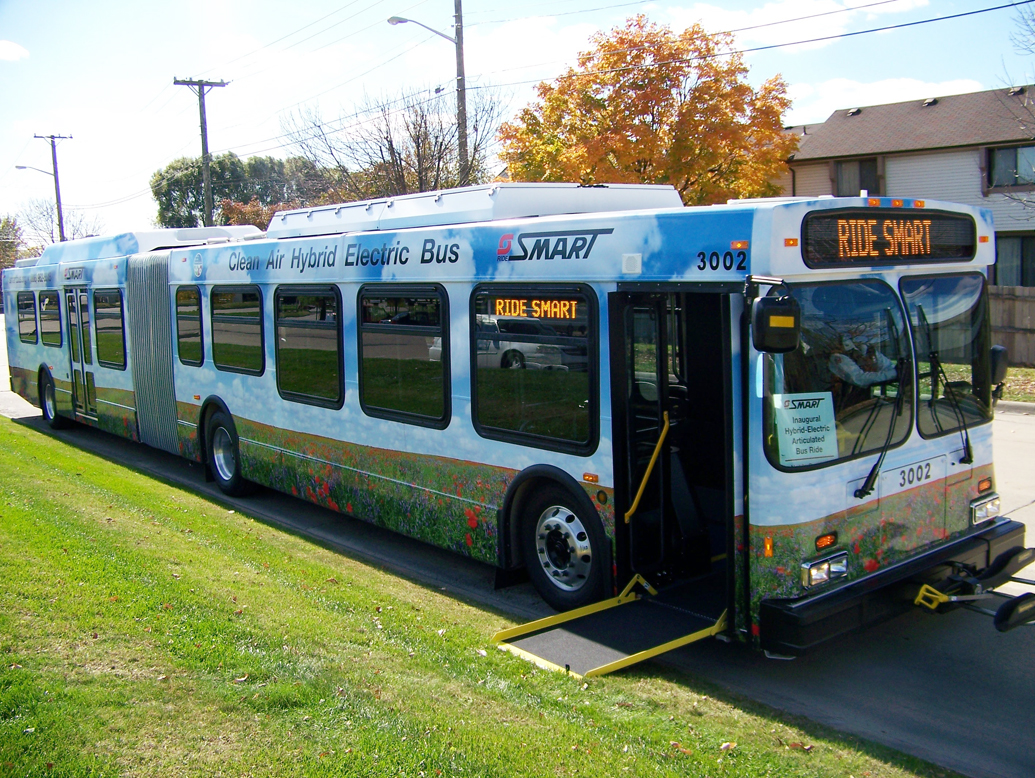 2009 – SMART purchased two hybrid electric articulated buses using ARRA funds. The first of its kind in southeast Michigan, the new hybrid-electric vehicles will help SMART accommodate riders along high-demand routes while helping the environment.
2009 – SMART purchased two hybrid electric articulated buses using ARRA funds. The first of its kind in southeast Michigan, the new hybrid-electric vehicles will help SMART accommodate riders along high-demand routes while helping the environment. - 2009 – During 2009 the legislature failed to approve legislation to develop a regional transit authority.
- 2010 – The population of Detroit drops to 713,777. The population of the tri-county region drops to 3,863,924.
- 2010 – The M1-Rail and DTOGS projects appear to merge into the Woodward Light Rail project. The initial agreement appeared to allow the M1-Rail plan as Phase 1 of the Woodward Light Rail project and allowing the private funding from M1-Rail to count toward the required matching fund for the federal full funding New Starts funding. However disagreements exist concerning alignment of the light-rail route.
- 2011 – The City of Detroit cuts DDOT bus operating subsidy and approves a bond issue to help fund Woodward Light Rail required match. No operating funds have been identified for the Woodward Light Rail.
- 2011 - SMART unveiled three hybrid electric 40 foot buses using ARRA Funds. The buses were painted in local university colors.
- 2011 – The FTA confirms that the region needs to have a regional transit authority and dedicated regional transit funding.
- 2011 – Governor Snyder proposes legislation that would form a regional transit authority and provide funding.
- 2011 – SMART cuts service by 22% due lower property values reducing the revenue collected through the .59 millage.
- 2012 - Oakland County overwhelmingly passed the SMART millage with a 79% approval.
- In December of 2012 Public Act 387 was passed by the Michigan Legislature and signed by Governor Snyder forming the Regional Transit Authority (RTA) for Southeastern Michigan. The intent of the RTA was to oversee the existing public transit agencies in the four counties of Macomb, Oakland, Washtenaw and Wayne and to develop and operate a rapid transit service serving the four counties.
- During 2013 the Regional Transit Authority for Southeast Michigan formed a 10-member board of directors, a 50-member Citizens Advisory Council and a Transit Service Providers Advisory Committee with members from the four public transit service providers.